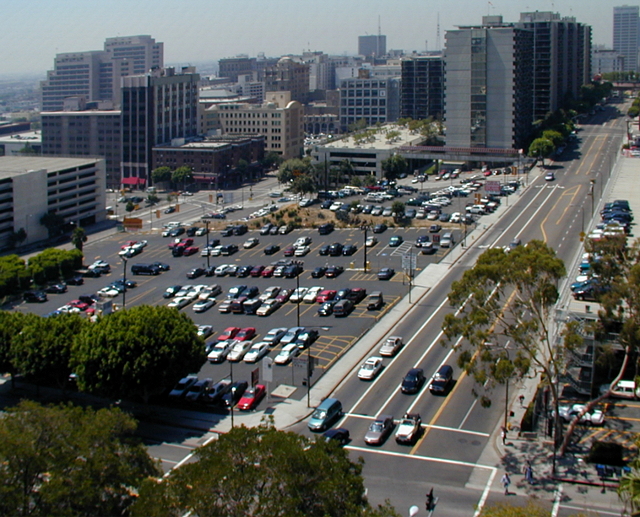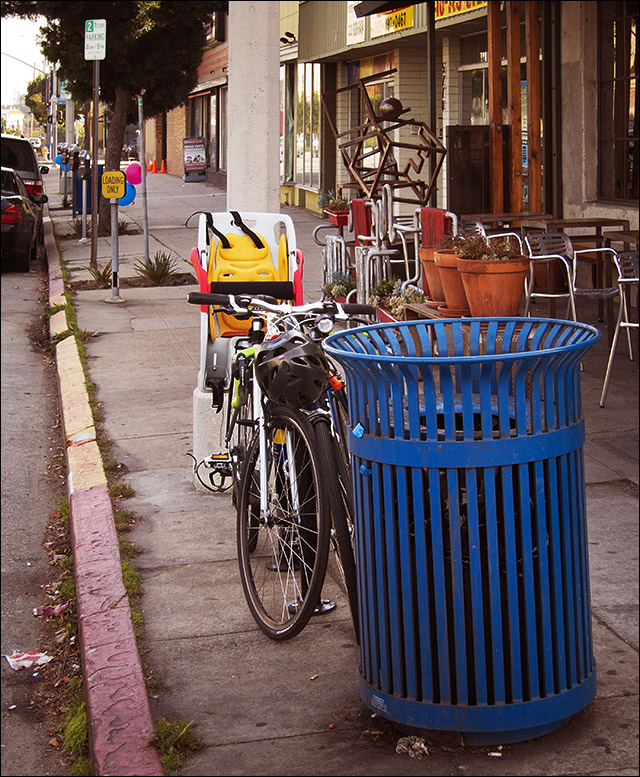Anyone who has brushed up against Donald Shoup‘s concepts from The High Cost of Free Parking understands this: that our country has made a severely misguided commitment to provide nearly universal free or below-market-rate private car storage everywhere throughout its cities, towns, and villages—at great cost to the entire populace, whether one drives 100,000 miles a year, five thousand miles, or not at all.
It’s not just the direct expense of providing all that asphalt, though this is high: onstreet parking spaces cost $3000 to $10000 dollars each just to build, and require constant maintenance, while indoor parking spaces cost far more—from $30k to $70k apiece, before maintenance. And every car in a city requires hundreds of parking spaces which, though each is used part-time for storage at home, at work, at stores, etc, add up in the aggregate to around eight parking spaces per car. These must be provided for a system based on private motor vehicles to function even as clumsily as it does now. (Public transit vehicles, I must point out, drop off their passengers and leave; they require only one parking space apiece, at their terminals.)

These spaces are paid for through property taxes—but even in private parking lots the subsidy continues. In most of the US (parts of Pennsylvania excepted), property taxes are assessed in an odd way: a tiny sliver of the tax is derived from the land area used up, and the bulk of the tax derives from the “improvements” to the land—that is, buildings and so forth. This has the adverse effect of punishing developers who build high-quality buildings, and rewarding those who install junkscapes such as parking lots. So you have the phenomenon of some of the most valuable land in a city—for example, in transit-rich downtown Los Angeles—used for cheap car storage instead of living, office, and retail space (which would generate jobs, local wealth, and municipal income) or community spaces such as schools, parks, libraries, and so forth, which provide social wealth—and make the city more attractive to employees, and hence employers, as recent articles on the benefits of bikeways have pointed out.
Indeed, it turns out that there is a huge opportunity cost in pandering to car cultists, as the necessary infrastructure takes up so much space that it crowds out other uses, both commercial and social, and lowers the value of those it does not obliterate. Indeed, while proximity to bikeways and Metro rail stations raises property values, no one wants to live or work next to a freeway, interchange, or high-speed arterial—and those who must do so suffer a myriad of physical and emotional ills besides losing money. it is an unconscious acknowledgment of this fact that has ensured most freeways and have been routed through poorer neighborhoods, perceived as being powerless to stop the projects. After all, the once-planned Beverly Hills Freeway was never built.
Bike parking, on the other hand, comes with little or no downside. Even when you take a former car spot for a bike corral, you are offsetting the opportunity cost with benefits car parking can never match: in the space of one car you can park ten to fourteen bicycles—bringing more people to an area than even a loaded van could manage, and bringing life to the street and income to its merchants. They also open sight lines for drivers, thereby improving safety for everyone (which is why bike corrals are almost always placed at corners).

But sidewalk bike parking is free of opportunity cost, because it’s placed in an area used by neither drivers nor pedestrians: that two-foot strip of walkway shared with trees, lampposts, signpoles, parking meters, trashcans, newsracks, mailboxes, and such. So for the cash cost of a single curbside parking spot spent instead on bent metal, you could instantly add the equivalent of twenty parking spaces to every block—without taking anything away.
And by thus encouraging more people to ride bikes rather than hop into the car for those up-to-three-mile trips that comprise half the travel in the US, you reduce the pressure to build and rebuild ever more extensive and more expensive motor lanes and socialized car parking.
When opportunity costs knock, tell them you’re not home. Build bikeways and bike parking, and help revive your city!
One Comment
I really like reading through an article that will make men and women think.
Also, thank you for allowing me to comment!